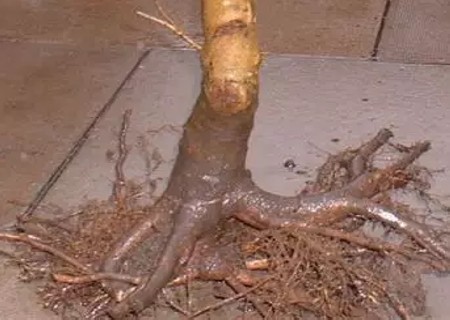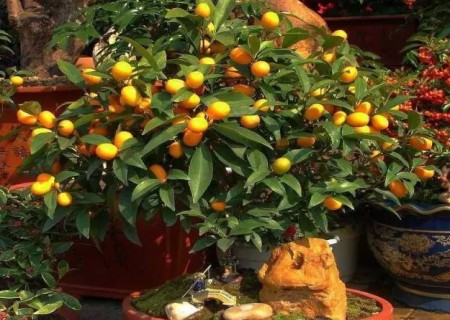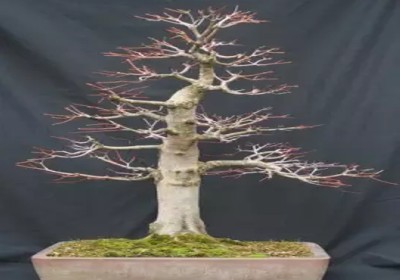Diagram of root filling process of maple bonsai
The root of the plant is the main artistic beauty of the stump bonsai. The defect of the root of the plant when it is young (the root of the potted plant develops on one side) will develop obviously with the increase of time, and the rooting will inevitably be damaged due to various reasons in the process of cultivation, which will affect the ornamental effect of bonsai. These defects are generally difficult to correct by means of pruning and ligation. The first root grafting method introduced here (Guangzhou people call it Ya Root) is to use artificial root filling to promote the "growth" of the stump root that needs to be reformed.
The stump down the hill is generally older and the root is larger. Due to the natural growth, the posture of the branches is very beautiful, and there are often deficiencies in the roots. when raising the billet, the method of replenishing roots can be adopted to induce new roots. If there is no root on one side of the stump, the leaning method can be adopted, and the same kind of seedlings can be planted close to the root. In the second year, the tree stump and replanting seedlings were cut off. This root filling method can restore the vitality and renew the growth of the defective root system of the old pile. The ideal root type can be molded by the method of root accumulation with tree stump.

This maple is cut, and it has been planted for 5 years after cutting. it is very strong both in thickness and root system.
The whole picture of the maple before it was transplanted into the basin.
For the location of missing roots, drill holes directly and penetrate the seedlings.
A year later, the seedlings with perforated access grew healthily and basically integrated with the big tree.
The next year, cut off the upper branches of the seedlings that have grown densely in the perforated parts. In places that are not very tight, apply growth healing agent to make the scion grow more healthily.
Five years later, the perforated branches are already very strong, and there is no need to leave the upper branches.
For the cut branch section, smear the wound healing agent to accelerate the wound healing.
Before re-changing the basin, the root system after cleaning is very developed, octahedral root disk, strong and powerful.
To make it easier to plant in a shallow basin and make the bottom flatter, carve the bottom of the root.
The sturdy close-up of the root system can clearly distinguish the primary root from the supplementary root.
A close-up of the location of the filling root.
The effect after putting on the pot. The height is 30 cm and the diameter of the trunk is more than 8.5 cm.
Nine years later, with the support of developed roots, the maple grew rapidly.
After so many years of training, the location of the drilling interface has been almost invisible.
After 14 years of cultivation, the appearance of the maple tree. The height is 35 cm and the trunk diameter is 7.5 cm.
Time: 2019-05-31 Click:
- Prev

The method of inverting pot and changing soil for bonsai of fruit trees
In order to ensure that fruit trees have high appreciation value every year, it is necessary to reasonably choose the frequency and timing of changing pots. If the frequency of changing the pot is too large, it will make the branches grow vigorously, resulting in less fruit in the same year; if the frequency of changing the pot is too small, it will deplete the nutrients of the basin soil.
- Next

How to replace maple potted plants
April is a good time to replace bonsai. Potted trees grow in limited pot soil. After a certain number of years, the fertility is exhausted, the soil layer is hardened, the roots are densely packed, and they are squeezed each other. It is difficult for new roots to grow. It is best to replace them with larger pots and fill them with new soil (changing soil without changing pots is also possible) to ensure the normal growth of potted trees.
Related
- Fuxing push coffee new agricultural production and marketing class: lack of small-scale processing plants
- Jujube rice field leisure farm deep ploughing Yilan for five years to create a space for organic food and play
- Nongyu Farm-A trial of organic papaya for brave women with advanced technology
- Four points for attention in the prevention and control of diseases and insect pests of edible fungi
- How to add nutrient solution to Edible Fungi
- Is there any good way to control edible fungus mites?
- Open Inoculation Technology of Edible Fungi
- Is there any clever way to use fertilizer for edible fungus in winter?
- What agents are used to kill the pathogens of edible fungi in the mushroom shed?
- Rapid drying of Edible Fungi

